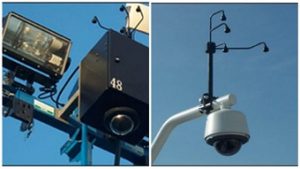
Maybe it was the ever-present sound of bubble wrap getting popped over the holidays, or, more seriously, the inundation and disgust many of us have felt over the past months over an endless parade of senseless shootings. Here is a look at gunshot detection technology available.
“When all preventative security measures have failed, gunshot detection systems can help provide a valuable tool when paired with appropriately developed human responses,” explains Brian Coulombe, Principal at DVS Security. “Like all security technology, a human being still has to interpret the situation, validate the alarm, and react appropriately.”
Louroe’s Audio Analytics
Louroe has partnered with a Netherlands-based company, Sound Intelligence, to enhance its sound-related product offering with audio analytics. Introduced in 2015, Louroe’s analytic algorithms are targeted at the applications of not only gunshot detection, but also aggression detection, glass break, healthcare monitoring and car alarms. The analytics work by using sound pressure levels at various frequencies, rates of rise, and amplitude – just some of the physical inputs into the system. The system relies on its integration with third-party video systems –in essence, think of the gunshot detection as an alarm input into a VMS, prompting operator analysis and response. “The price of a false alarm is enormously high, thereby mandating human verification,” says Cameron Javdani, Louroe’s Director of Sales and Marketing, noting that there is typically a few-weeks adjustment period to get the system tweaked. Javdani sees the trend toward the increased use of big data and automation making these systems even better, and he notes key verticals for the technology, including education, corporate, government (including city surveillance) and healthcare.
ShotSpotter for Public Safety Applications
Founded in 1996, when it was issued its first patent, ShotSpotter began to focus and significantly expand after getting its first VC funding in 2004. The company’s technology is home-grown, with 30 patents to its credit. The technology has been deployed in more than 90 cities worldwide.
Virtually every public safety application is a custom designed sensor array, optimized for a given geography in terms of sensor density and positioning; however, occasionally, positioning of light poles and desire of a municipality to use these may dictate sensor patterns. Inputs from 3-4 sensors are needed to triangulate the gunshot location, although more inputs may be picked up from additional sensors in the array.
“The sensor arrays are engineered to compensate for the possible loss of sensors and to provide redundancy and resiliency,” explains Gary Bunyard, the company’s SVP of Public Safety Solutions. ShotSpotter splits its marketing into two areas: Public safety, focused on relevant outdoor applications, and security, covering other outdoor and indoor applications.
Each outdoor sensor has its own cellular capability and communicates into a cloud-based algorithm which, after the number crunching is performed, reports its findings to operators at the company’s Incident Review Center for further analysis and verification.
The automated first phase is said to be about 80-percent accurate, where the human-based second phase gets closer to full accuracy. Response time is typically 25 seconds, although SLAs usually provide for less than 60 seconds 90 percent of the time. While caliber discrimination is not regarded as viable, detection of multiple shooters, high capacity automatic weapons, as well as direction and rate of movement of shooter is doable now. Further, ShotSpotter is testing various AI/Cognitive platforms to determine their efficacy in improving its machine classification capability.
SDS: Raytheon-Based Technology Adapted for Commercial use
A system called Bullet Ears was developed by a company called BBN Technologies – later acquired by Raytheon – and tested by DARPA (Defense Advanced Research Projects Agency) for use in military environments as early as 1996. Bullet Ears used a microphone network to detect the shock wave from a bullet and computer analysis to “plot the bullet’s path.”
Bullet Ears eventually evolved into the Boomerang system – said to be the most widely fielded gunshot technology in the world – with its proving ground coming in hot combat areas such as Iraq and Afghanistan. According to Raytheon: “Whether vehicle-mounted or in a fixed position, Boomerang detects small arms fire travelling toward it for bullets passing within approximately 30 meters of the mast-mounted compact array of microphones, even when shooters are firing from maximum effective weapons ranges.”
The system is not triangulation-based, but rather employs complex and proprietary signal processing that deals with the extreme challenges of environment, background noise, acoustic reflection, etc. Shooter Detection Systems spawned from Raytheon in 2013, as it purchased technology rights for the indoor market and is the exclusive licensee for U.S. outdoor sales applications. Indoor applications add IR sensing capability to detect the muzzle blast, and use that to help validate the acoustic-based detection.
Christian Connors, Shooter Detection Systems CEO and a BBN alum, says their systems have more than 20 million hours of installed operation without a single false alarm, adding that “emptying buildings is not a joke, so we take FAR very seriously.” Each POE-powered sensor is a point solution and no human intervention is involved. Decision time is 750 msec. Connors does not believe that AI is required to enhance the performance of the system, given its proven accuracy; however, it may be helpful in discerning other types of threats











